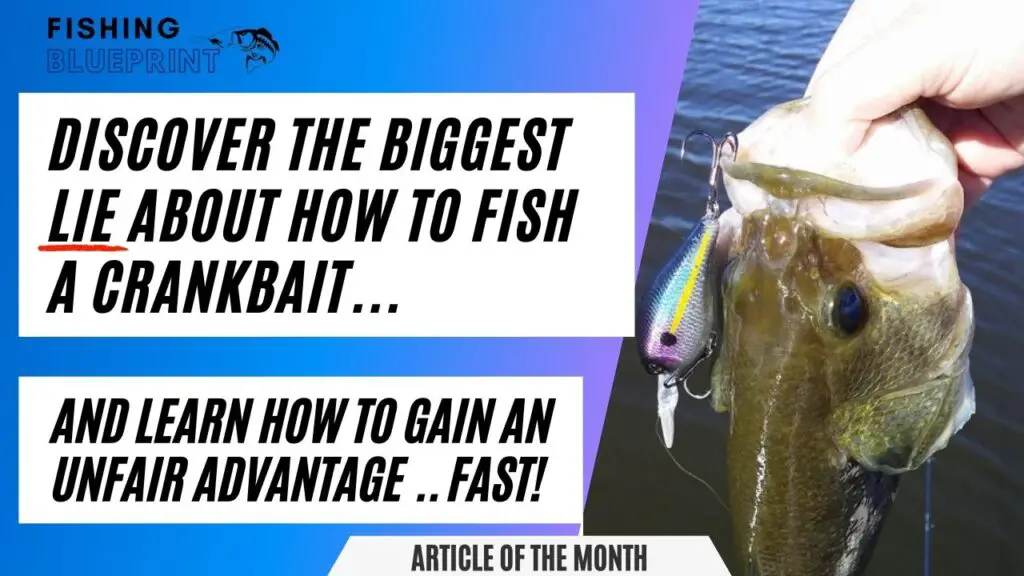Diamond Valley Lake Fishing Report
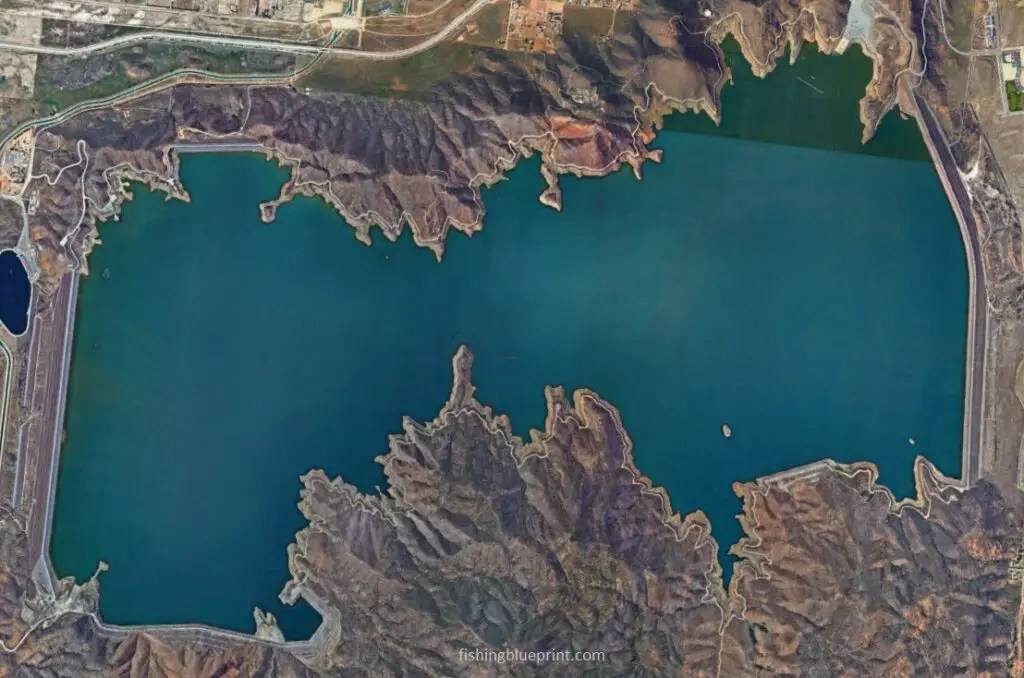
Diamond Valley Lake is a large man-made reservoir that sits 95 miles away from downtown Los Angeles, or 471 miles away from San Francisco.
Overall it’s a popular lake known for its largemouth bass and striped bass fishing. In the winter Diamond Valley Lake is planted with rainbow trout. In this post you’re going to be given the blueprint to fish this lake.
So what are the best tips for fishing Diamond Valley Lake? There are three important factors you must know if you want to know how to fish Diamond Valley Lake successfully. First, you need to know what kind of fish is in Diamond Valley Lake. Second, it’s important for you to know which part of the lake each species can be found. Lastly, knowing what are the best baits that work on Diamond Valley Lake is vital. However, tactics, baits, and locations will be different for each type of fish that you target. So let’s talk about the steps you need to take in order to give you the best chance of catching a fish on Diamond Valley Lake.
Key Takeaways
This lake gives locals and visitors the opportunity to test their luck in catching one of the many game species this lake has to offer, such as trout, striped bass, largemouth bass, catfish, bluegill, and much, much more!
Here’s the most recent and updated Diamond Valley Lake Fishing Report – it gives you a quick and easy list of some really good fishing spots. If you’re looking for more detail on how to fish each spot scroll down into the article.
- Wildflower Coves
- The Wall
- Eastern Dam
- Rawson Cove
- Saddle Dam & Cove
- The Cutout
Here are some additional fast and helpful tips just for you:
- The easiest way to fish this lake is by boat, but there are areas to fish from the bank, or by kayak or canoe.
- There are public boat ramps to use.
- Camping and RV parking is available.
- You can buy tackle and groceries at the lake or at one of the tackle shops in Hemet.
About Diamond Valley Lake
Diamond Valley Lake is one of the largest and deepest man-made lakes in southern California. It’s average depth is 110 feet and a maximum depth of 260 feet when the lake is completely full. Being just under 4.5 miles long, fishing at Diamond Valley Lake can be amazing when you have 26 miles of shoreline to fish.
Important Lake Warnings
One of Southern California’s newest reservoirs is Diamond Valley Lake.
No one is permitted to touch the lake since it provides drinking water, t herefore, it is prohibited to swim, wade, water ski, etc.
Additionally, the kinds of boats, motors, and fuels that may be used on the lake are restricted and the maximum boat speed limit is 25 MPH.
Parking spaces are scarce, thus reservations are advised, so we strongly encourage you to contact the Marina.
Address: 2615 Angler Ave, Hemet, CA 92545
Hours:
Sunday 5:45AM–4:30PM
Monday Closed
Tuesday Closed
Wednesday 5:45AM–4:30PM
Thursday 5:45AM–4:30PM
Friday 5:45AM–4:30PM
Saturday 5:45AM–4:30PM
(Christmas Eve) 5:45AM–4:30PM
Hours might change without notice
Phone: (951) 926-7201
Daily charges are as follows: Entry/Parking $11, Boat Launching $13, Fishing $9 ($6 for children under 12), and Shoreline Access $4.
yearly passes Vehicle is $165 and Launch and Parking is $399.
Algae blooms may be present which may affect fishing, swimming, and water contact in general.
According to parks.ca.gov, “every one of California’s new laws requires boat operators to have a California Boating Card. The card is required for anyone under the age of 41 to operate a boat in California’s waters.”
If you are fishing and camping, fire bans may be in effect due to the ongoing drought conditions.
What Kind Of Fish Are In Diamond Valley Lake
- Rainbow Trout
- Largemouth Bass
- Smallmouth Bass
- Spotted Bass
- Striped Bass
- White and Black Crappie
- Bluegill and Sunfish
- Catfish
Diamond Valley Lake Fishing Tips & General Strategies
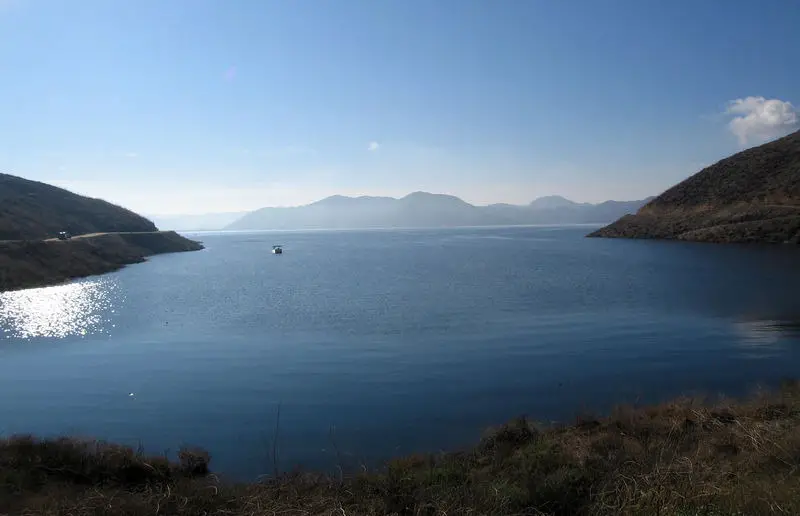
This is one of California’s best bass fishing lakes.
And if if you’re in southern California, this should be one of your stops due to the amount of bass you can catch and how large they get!
Stripped bass, crappie, catfish, and trout are also in large quantities in this lake.
Unfortunately this lake can be a challenge to break down this body of water… So that’s why I created this Diamond Valley Lake Fishing Report to help you to easily start catching fish fast!
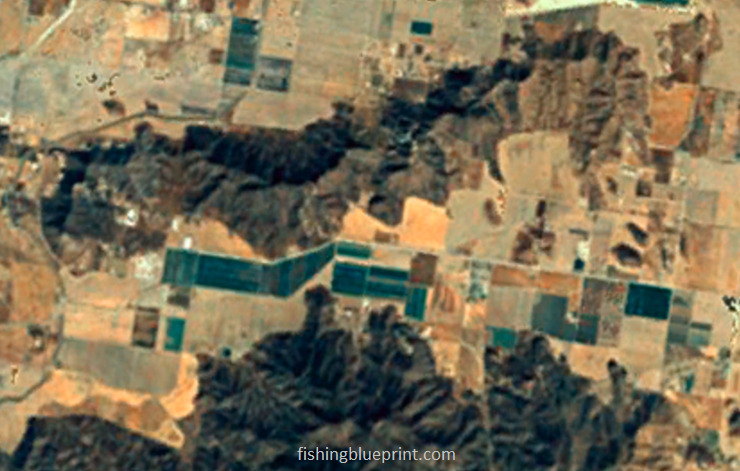
Diamond Valley Lake used to be a farming community before the land was bought out and a lake was created.
The surrounding mountains that create the lakes boarders are steep and lined with chunk rock banks, although there are some areas with shoreline vegetation.
Most of the fish such as bass, bluegill, crappie, and catfish will spawn in the spring. Bass will spawn in 1’-15’-feet of water notably on rocky structure, gravel flats, humps, and small creek inlets and cuts.
When the summer heat sets in, the bass, bluegill, and crappie will move to deeper water to approximately 15’-30’-feet of water.
Focus on drops offs, channels, points, submerged humps. Deeper area with chunk rock ranging from baseball to basketball size will attract predatory fish like bass, crappie and catfish because it provides a safe area the prey (crayfish, bream, and minnows) can hide.
If you can find the ideal spot at the ideal depth then it will most likely assist you in catching fish.
Springtime Fishing update
Water Clarity:
- Diamond Valley Lake is known for its insane water clarity. Expect visibility of up to 20 feet when conditions are right – no joke.
- Time to put on those polarized shades and spot some submerged cover the bass love to use here.
Structures and Fishing Cover:
The lake has plenty of nooks and crannies for you and your fishing buddies to check out. There are ton of structure and cover for the bass to hide in. Here’s a quick rundown of what you’ll find when searching for the perfect bass hangout:
- Rocky Points: These are the lake’s true jewels. Many a bass has been caught hugging these rocky shores.
- Coves and Bays: These watery hideaways are prime real estate for the lunker lurking just below the surface.
- Drop-offs and Ledges: The lake’s many sudden depth changes create the perfect ambush spot for bass to feast and they feel comfortable because when they feel threatened they have deeper water they can retreat to.
- Underwater Islands: Like an aquatic Atlantis, these submerged structures offer the perfect hideout for bass looking to ambush their prey.
- Tule Thickets: The shallow water vegetation is a bass favorite for cover near the shore, providing a green and leafy jungle for your future trophy catch.
- Submerged Weedbeds: These underwater forests provide both cover and give the bass ambush spots when little bait fish swim by.
Diamond Valley Lake – Summer Fishing update
As of now, springtime at Diamond Valley Lake is a mix of sunny and breezy days, which makes it a great place to fish for bass. Here’s what you can expect from this lake right now:
Air Temperature:
The air temperature at the lake in the spring ranges from a cool 60°F in the beginning of spring to a warm 80°F by the end of spring.
Wind Speed and Direction:
This spring, the average wind speed is between 5 and 10 mph. At the moment, most of the wind is coming from the west or southwest.
Spawning Largemouth Bass
Now that the water has hit 60°F, largemouth bass are busy laying eggs. For this lake this happens between the end of February and the beginning of May. The best places to find these fish are:
Shallow Rocky Coves: Largemouth bass like to nest in shallow coves that are safe and have a mix of sand and rocks. They can be easily found in shallow coves, especially in the eastern and western arms of the lake.
Tule Beds: Tule beds is another good place to find spawning bass. You’ll find a lot of tule beds in the southern part of the lake, where there is a lot of shallow warm water.
The presence of Striped Bass
The way striped bass spawn is a little bit different, in fact they like to spawn in current. Anglers have reported they have seen the stripers around two particular locations:
Near Drop-offs: Striped bass often gather near drop-offs and rocks, especially in the area of Rawson Cove.
Main Lake Points: Striped bass can also be found in and around the lake’s main points, especially near the marina and the dam.
But Where Are The Best Places To Fish At Diamond Valley Lake?
And in no particular order here is that list of the best fishing spots at Diamond Valley Lake.
DISCLAIMER: The material provided is for general information purposes only. It’s important to understand that any information provided in this article can change at any time. Any maps or graphics featured are not to be used as navigational aids. Fishing Blueprint will not be responsible for any personal injury or property damage from any misuse of the maps or graphics provided. It’s completely impossible to give you every single spot where you can potentially catch a fish. But, what this list does do is to give you a helping hand and narrow down to the most productive fishing spots.
Wildflower Coves
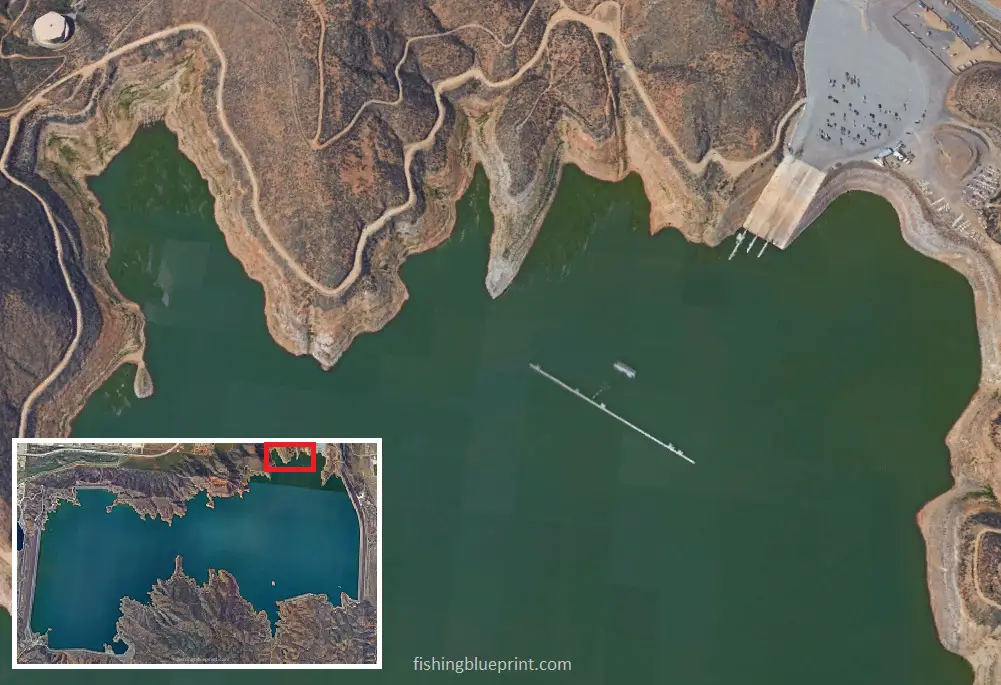
This area consists of 3 small, yet deep coves just off the main lake with several ditches that drain into it. There are also several drop offs and ledges which makes it unique.
It’s close to the boat ramp and offer shoreline fishing.
Located: north east side
Structural features: deep rocky coves, creek channels, ledges.
Best species to target: bass, crappie, sunfish
Most effective way to fish this spot: boat or kayak
Eastern Dam
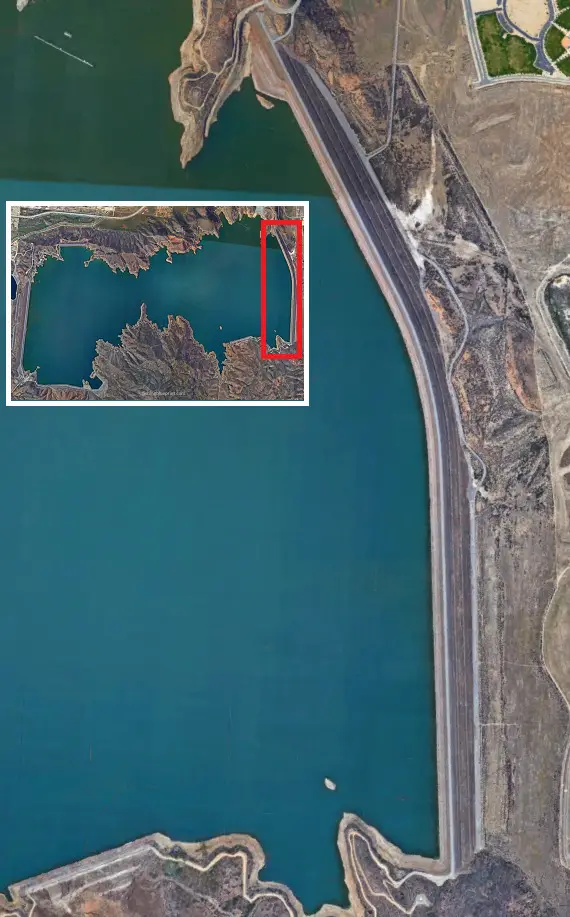
The eastern part of Diamond Valley Lake features the longest manmade dam.
This dam is covered with a variety of large rocks, ranging from small boulders to basketball-sized stones, known as “rip rap.”
The banks in this area are steep, with a 45-degree downward angle.
Numerous small fish and creatures like crawfish, bluegill, minnows, and shad inhabit this region, attracting larger fish such as bass.
To increase your chances of catching fish here, concentrate on areas where the rock sizes change and where the rocks form a point. Look for the largest rocks in these locations.
During summer, using topwater lures is effective one hour before and after sunrise or sunset. In the middle of the day, return to this area and utilize a fish finder to scan for a line in the water where the temperature shifts, called the thermocline. Bass tend to swim just above this line. Once you locate it, use a lure that can reach that specific depth to target fish near the rip rap points.
Located: east side
Structural features: rip rap banks
Best species to target: bass, crappie, sunfish
Most effective way to fish this spot: boat or kayak
The Wall
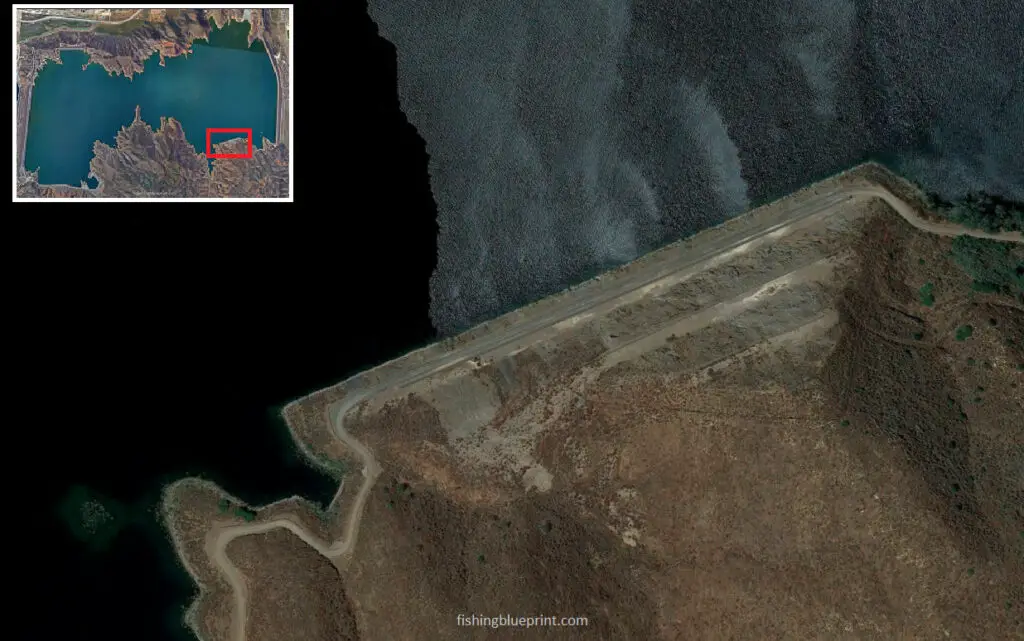
This spot I call The Wall. It was created by the construction crew that dug out the rocky material to help build all three of this lakes dams.
The this bank is covered in thick chunk rock, in which the size can range from small boulders to basketball sized rock (also known as “rip rap”). It also holds some boulder patches.
The banks are also steep in this area.
Look carefully at this spot with low water level…

Located: east side
Structural features: rip rap banks
Best species to target: bass, crappie, sunfish
Most effective way to fish this spot: boat or kayak
Rawson Cove
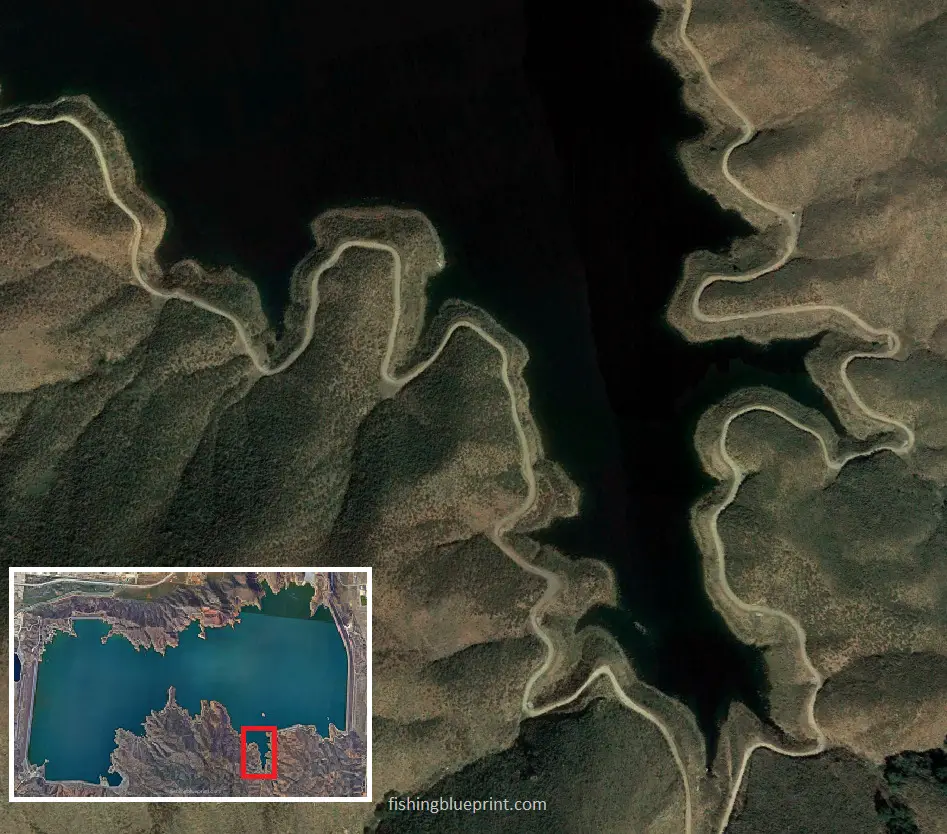
Rawson Cove is a long and wide straight cove features a deep channel fed by several feeder creeks.
A really great hallmark about this fishing spot is there is one main creek channel that runs down the middle of it however, there are several other ditches (smaller secondary creek channels) that run into it, kinda like a leaf.
Look carefully at this spot with low water level…
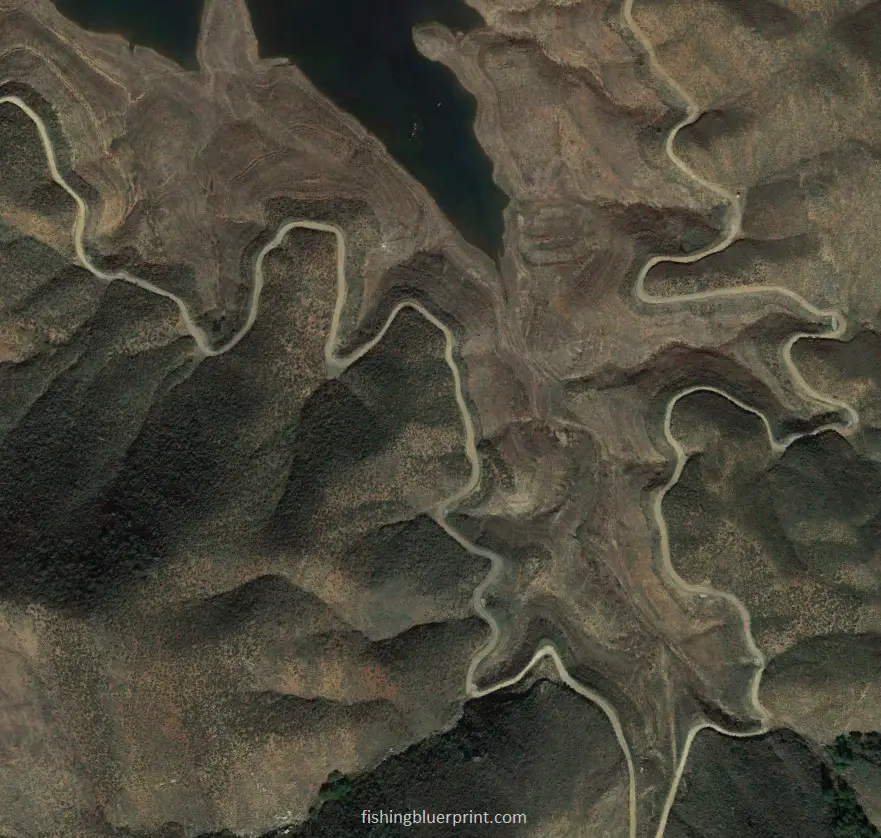
The channel holds a large amount of submerged brush, ledges, rock piles, along with submerged humps, and sharp channel swings.
This is a great area for spring bass and crappie fishing.
The mouth of the cove is great for trout in the late winter and early spring fishing.
Catfish can be caught in the backs of the bays using cutbait, chicken livers, hotdogs, or premade stinkbait.
Sunfish/panfish can be caught using small trout flies, dough balls, and Slim Jim pieces.
Located: south lake
Structural features: deep water at the mouth, submerged and emergent vegetation, rocky structure, artificial structure
Best species to target: trout, largemouth bass, smallmouth bass, crappie, catfish
Most effective way to fish this spot: boat
Saddle Dam & Cove
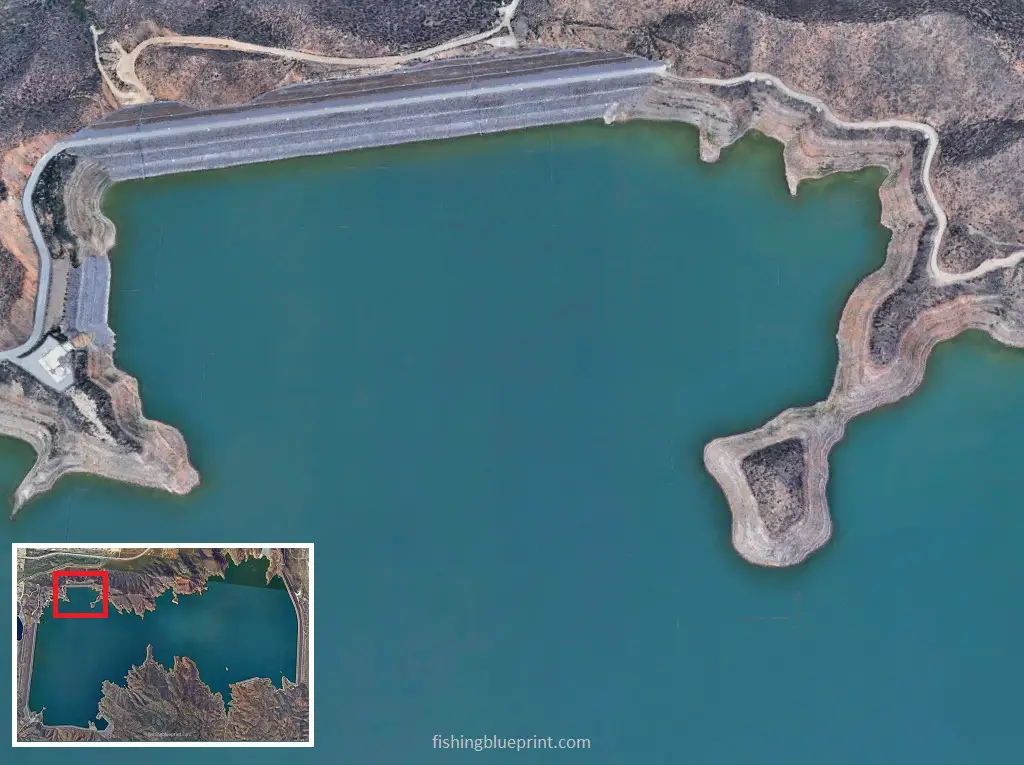
This is a big cove that is also home to Saddle Dam, which is the lake’s smallest dam.
I think this is one of the best places to fish. It gives anglers a lot of different places to fish, like long riprap banks, multiple points, ledges, ridges, drop-offs, rock piles, and humps.
This spot goes off in spring and fall.
Before you try to fish everything, make sure you take some time to check these areas with your fish finder to see if there are any bait fish or bass there. If there is bait chances are the bass are near by to be fished.
Located: east side
Structural features: rip rap banks, creek channels, ledges, and points.
Best species to target: bass, crappie, sunfish
Most effective way to fish this spot: boat or kayak
The Cutout
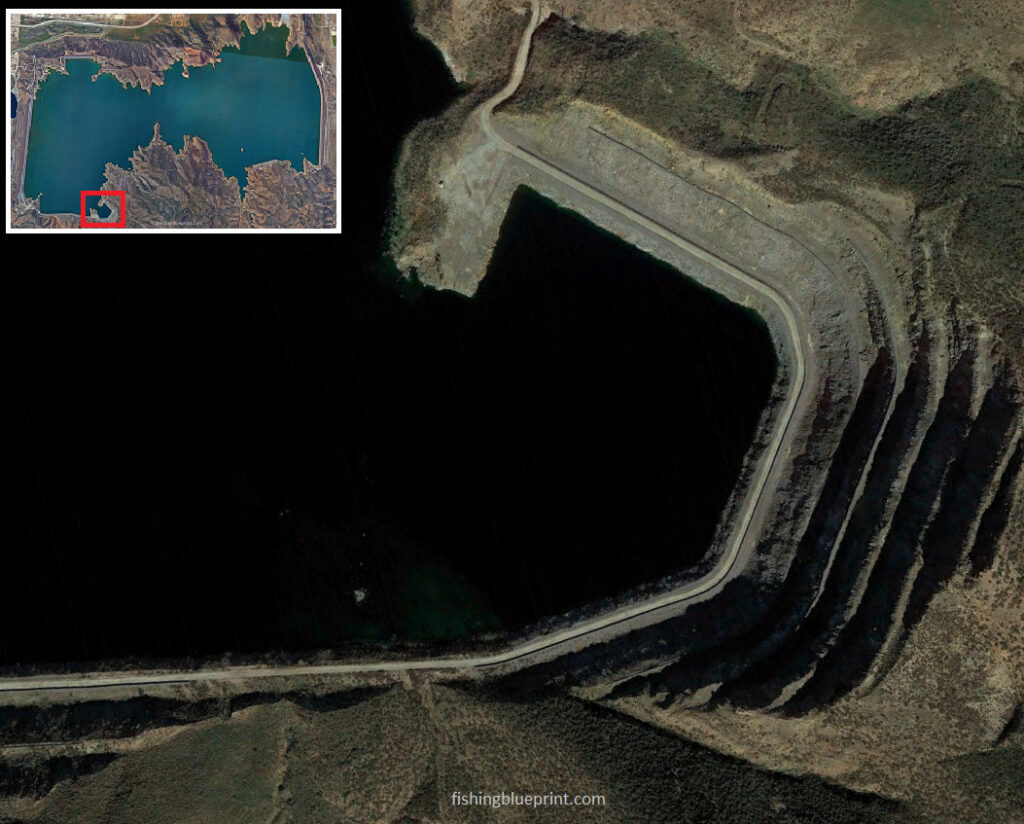
This is a large cove that also is home to Diamond Valley Lake’s smallest retention dam, Saddle Dam.
This has to be one of the most popular places to fish because it can be so productive.
If you can fish this area during the week when there is a slower amount of boat traffic, then this can go off!
It gives the angler many different structures you can target and fish, such as long riprap banks, brush piles, ledges, ridges, drop offs, boulder piles, and ridges humps.
Areas like these are phenomenal during the spring and in the fall.
Before trying to fish everything, be sure to take some time and scan these areas first with your fish finder to see if there are any bait or bass relating to that particular spot. If you see bait or bass in the spot then fish it.
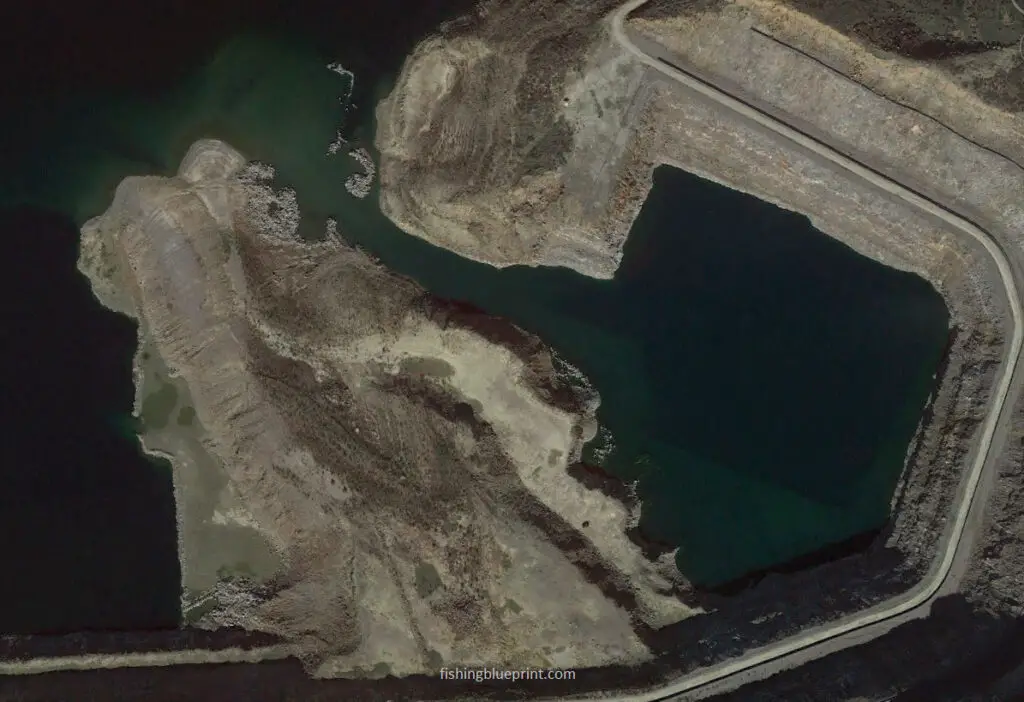
Located: south west side
Structural features: rip rap banks, creek channels, ledges, humps, brush piles, and points.
Best species to target: bass, crappie, sunfish
Most effective way to fish this spot: boat or kayak
Boat Ramps & Boat Launch at Diamond Valley Lake
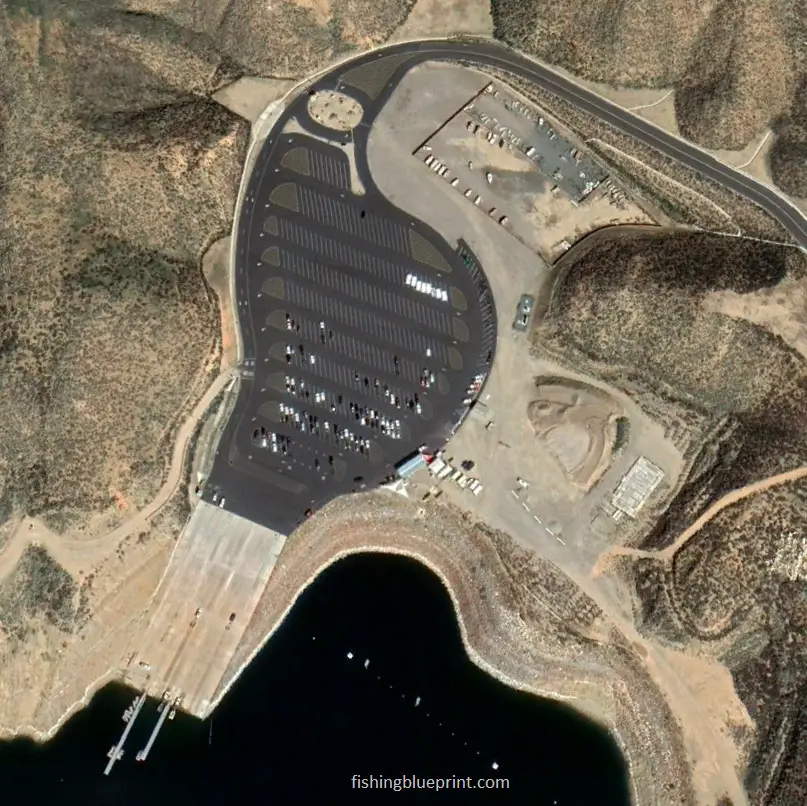
Diamond Valley Lake Marina
2615 Angler Ave, Hemet, CA 92545
(951) 926-7201
Lanes: 6
Restrooms: Yes
Fish Cleaning Station: no
Showers: no
Gas: no
Camping nearby: Yes
Tackle Shops Near Diamond Valley Lake
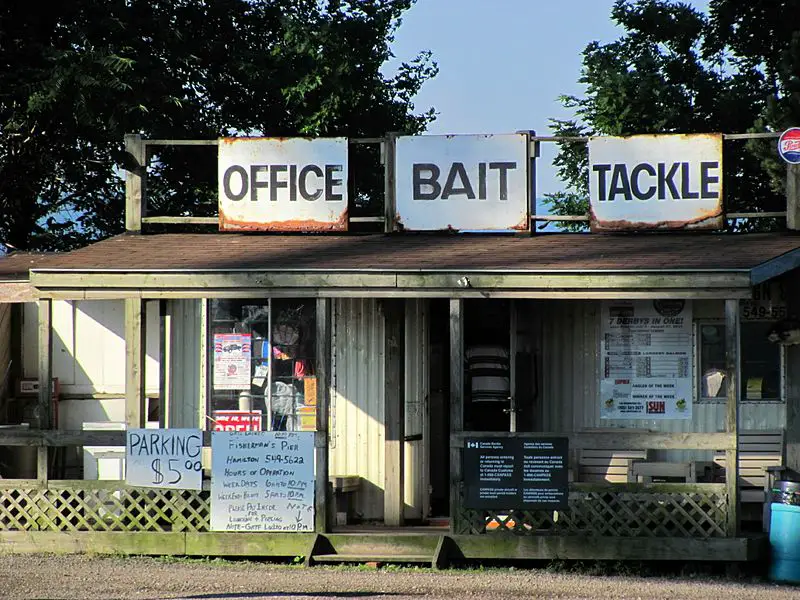
Last Chance Bait & Tackle
3356 Wentworth Dr, Hemet, CA 92545
lastchancetackle.com
(951) 658-7410
Brass & Bass
39825 Alta Murrieta Dr b14, Murrieta, CA 92563
brassandbass.com
(951) 677-3316
Sportsman’s Warehouse
25070 Madison Ave, Murrieta, CA 92562
sportsmans.com
(801) 566-6681
Outer Banks Tackle and Sports
43169 Vía Dos Picos, Temecula, CA 92590
outerbankstackleandsports.com
(951) 406-3775
Camping Near Diamond Valley Lake

There are no campground near Diamond Valley Lake
Other Activities You Can Do At Diamond Valley Lake
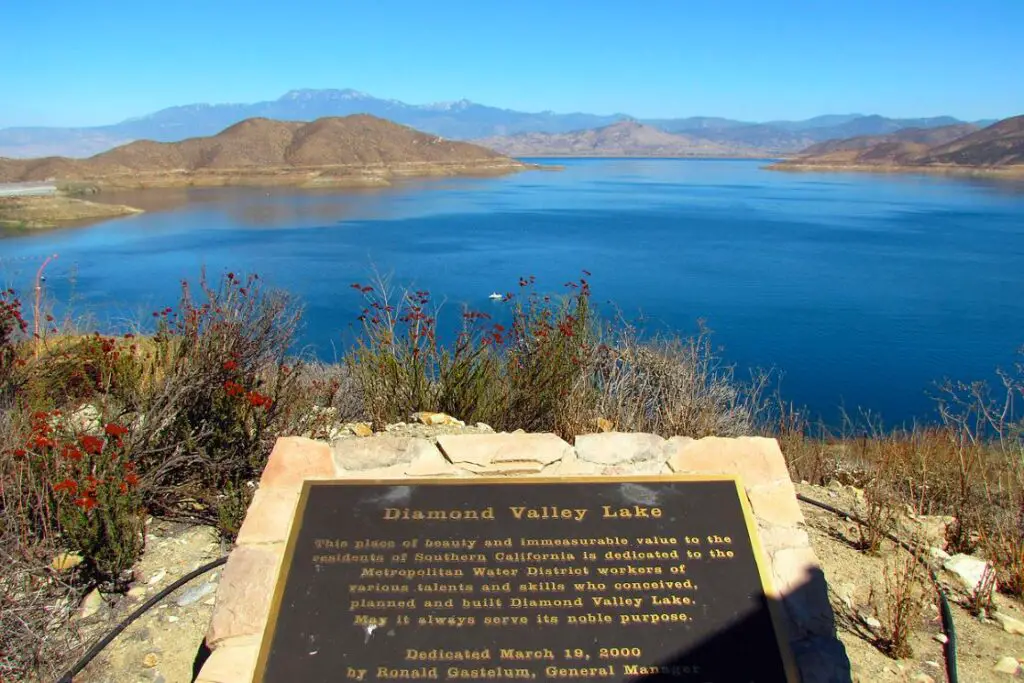
Fishing is not the only thing that brings people to the beautiful body of water. Here’s a list of other things you can do!
- Diamond Valley Lake Aquatic Center
- Western Science Center
- Biking
- Bird watching
- Boating
- Kayaking
- Canoeing
- Sailing
- Camping
- Horseshoes
- Picnicking
- Hiking
- Gentle walking trails
- Nature photography trails
- Wildlife viewing
- Mountain biking
- Stargazing
- and most importantly… relaxing.
In Summary...
As you now can see Diamond Valley Lake fishing can be tough at times, but it’s not impossible and with the help of the Diamond Valley Lake Fishing Report… It definitely helps you get started on the right foot quickly and easily, so you can avoid wasting hours wondering where and how to get started.
Did You Get All This?
As fellow fisherman and content creator I thrive on helping others… I feel like I can do the most good by helping others… And frankly… I would feel like I did something wrong if you didn’t walk away feeling a little better about this lake.
I truly want to over deliver for you…
So Let Me Ask You Another Question…
After reading this helpful report:
- Can you see how this could change the way you would fish this lake?… To make it easier, faster… and… with less headache, less frustration?
- If nothing else, do you now have a better sense of where you can get started, even if you have have been here?
- Do you feel that you have a good grasp of what species to expect in this lake?
- Do you have a good understanding what baits are needed to catch each of the different species of fish?
- Earlier we came up with some helpful spots to catch more fish, can you see yourself considering any one of those spots? Which ones are you the most excited about implementing when you get to the lake?
- Is it fair to say that using these spots would give you a significant advantage over someone else who’s fishing this lake?
I Need To Ask A Favor From You And It’s Not Going To Cost You A Single Dime…
If you have gotten anything out of this free report; whether its knowing where to get started, what kinds of fish are in Diamond Valley Lake, what baits to use, where to launch your boat, where to buy a frosty beverage, where to camp, and other things to do when you’re at this lake…
Then I need you to do something that is going to help your fellow angler…
And that is share this report. Please share it to as many people as you can. It’s free to you and it really helps me out as a creator.
Lastly… thank you for spending your time reading through this report and I hope you have a luck on the water.
THIS IS WHERE YOU CAN HELP ME THE MOST: There’s a lot of information about this subject you have found helpful, and I’m sure you’ll be able to put some of the knowledge bombs to use. But sharing this report helps drive traffic which in turn helps me at absolutely no cost to you. I love creating reports like this for you, and you like reading these types of reports please share this with your friends, family, and fellow anglers.
Click on your favorite social media buttons to share this page now!
Other California Related Fishing Articles
- Bass Lake Fishing Report
- Clear Lake Fishing Report
- Castaic Lake Fishing Report
- California Delta Fishing Report
- Diamond Valley Lake Fishing Report
- Don Pedro Reservoir Fishing Report
- Eagle Lake Fishing Report
- El Capitan Reservoir Fishing Report
- Lake Berryessa Fishing Report
- Big Bear Lake Fishing Report
- Folsom Lake Fishing Report
- Irvine Lake Fishing Report
- Lake Almanor Fishing Report
- Lake Camanche Fishing Report
- Lake Isabella Fishing Report
- Lake Havasu Fishing Report
- Lake McClure Fishing Report
- Lake Oroville Fishing Report
- Lake Perris Fishing Report
- Lake Piru Fishing Report
- Lake Skinner Fishing Report
- Lake Tahoe Fishing Report
- Los Banos Reservoir Fishing Report
- New Hogan Lake Fishing Report
- New Melones Lake Fishing Report
- O’Neill Forebay Fishing Report
- Pardee Lake Fishing Report
- Pyramid Lake Fishing Report
- San Luis Reservoir Fishing Report
- San Vicente Reservoir Fishing Report
- Shasta Lake Fishing Report
- Silverwood Lake Fishing Report
- Trinity Lake Fishing Report
- Whiskeytown Lake Fishing Report
More articles just for you...
Funny Fishing Rules, Laws, and Regulations 2025
Crazy Fishing Laws That Will Blow Your Mind! #7 is INSANE! Strange Fishing Regulations and Laws As silly as hook and rod limits may seem,
EXPOSED! How To Use A Spinnerbait The Right Way for 2025
Are You Wondering How To Use A Spinnerbait? Or How To Work A Spinnerbait Over Grass, Logs, or Points? Well, All These Questions Are Answered
EXPOSED! Best Crankbait Colors for 2025 [Which to Buy & Avoid]
What color crankbait to use? Crankbait Color Chart I just love going into a Bass Pro Shops store and just staring at all the walls
Best Underwater Dock Lights For Fishing – 2025 Buyers Guide
Night Dock Light Fishing For Beginners Dear fellow angler, Does this sound like you? You’re someone who loves fishing but just wants to escape the
15 Best Deep Diving Crankbaits [2025 Buyers Guide – Which to Buy & Avoid]
A Complete Buyer’s Blueprint On The Best Deep Diving Crankbaits for Bass, Walleye, or Striped Bass On The Market Today Fishing deep diving crankbaits can

